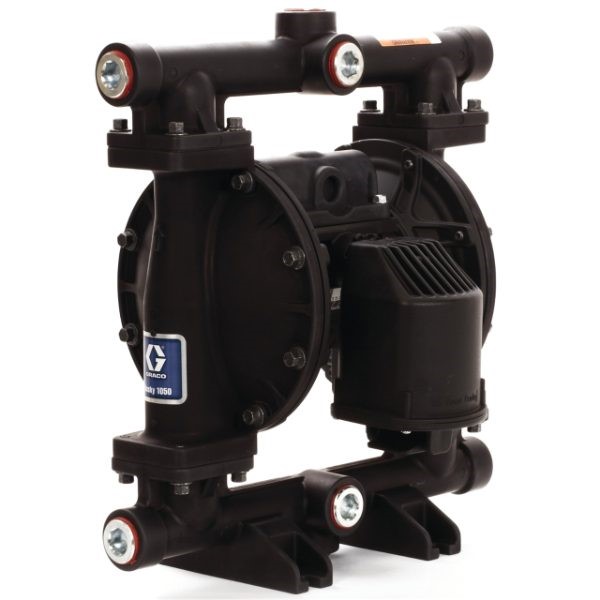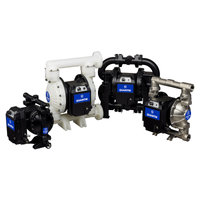What is a progressive cavity pump and what is it used for?
Understand the advantages and disadvantages of progressive cavity pumps and their common uses and applications.
What is a progressive cavity pump?
Progressive cavity pumps (also known as screw pumps or PC pumps) are used in a wide variety of industries and applications to transfer and dispense medium to high viscosity materials. Their steady flow and resistance to high temperatures makes them common options for transferring oils, cosmetics, paints, adhesives, and other abrasive or corrosive materials.
While progressive cavity pumps have their benefits, they also have limited material/application compatibility with fluids and involve significant maintenance costs due to their complex mechanical seals.
How does a progressive cavity pump work?
Progressive cavity pumps have two main components: a rotor and a stator. The rotor and stator work together to create sealed cavities for the fluid to pump through. The fluid then flows through these cavities from the suction side to the discharge side of the pump as a result of the rotor rotating inside of the stator. This rotation of the rotor creates a pulsating flow which results in a continuous pumping action. The stator is typically made out of a durable material like rubber or elastomer to withstand abrasive materials. The rotor, on the other hand, is usually made of a metal alloy for added strength.
Progressive cavity pump advantages
- Progressive cavity pumps can handle high viscosity fluids
One of the big advantages of a progressive cavity pump is its ability to handle high viscosity fluids. Unlike many other pump types, screw pumps can effectively move thick and sticky fluids such as sludge, adhesives, and oil. - Progressive cavity pumps are capable of self-priming
Progressive cavity pumps are self-priming, which means they can start pumping without any external assistance. This eliminates the need for manual priming, which saves time and effort during pump start-up. - Progressive cavity pumps are more efficient than many other pumps types
Because of their efficiency, screw pumps generally take less energy to run than many other common pump types, which can decrease overall costs. However, some pump types, such as electric diaphragm pumps, are even more energy efficient than progressive cavity pumps.
Progressive cavity pump disadvantages
Progressive cavity pumps can suffer from certain disadvantages that can lead to frustrating downtimes, expensive repairs, and even potential replacement costs.
- Progressive cavity pumps have a troublesome mechanical rotary shaft seal
The majority of progressive cavity pump drives transmit their power to an internal screw through the pump casing using a rotary shaft seal. This mechanical seal is an expensive wear part and is sensitive to increased temperatures, abrasives, and non-lubricating liquids, which increases the risk of leakages over time. Furthermore, the mechanical seal itself raises sanitation/contamination concerns in hygienic industries like food/personal care processing. One of the most important disadvantages of the mechanical seal is the material being pumped can be altered by the force of rotation and friction of the shaft and seal, further heating the liquid. - Progressive cavity pumps should never be allowed to run dry
Progressive cavity pumps cannot run dry without destroying the stators and rotors, causing expensive repairs. The material/fluid being pumped always has to be present to lubricate the contacting surfaces between the rotor and stator. In fact, running dry is the most common failure of screw pumps. In particular in food and beverage manufacturing applications in particular, additional sensors monitoring the availability of material at the pump inlet can create more potential leak paths and locations for bacteria growth in the system. - Progressive cavity pumps have a large footprint
Because of their intricate design, progressive cavity pumps take up a lot of space, particularly when it comes to higher flow rates. The motor, pump housing, and the “progressive cavity” itself physically require space that cannot be designed out of the system. - Progressive cavity pumps consume high amounts of energy
When it comes to operating costs, a big disadvantage is that screw pumps are expensive to run compared to other electric pump technologies. Due to high friction resistance, they have high energy consumption. - Progressive cavity pumps are not suitable for pumping abrasives
When pumping chemical fluids or fluids with a highly abrasive content, a screw pump’s stators and rotors will quickly wear out and will need to be replaced. Some fluids also cause the elastomers in the stators to swell. Moreover, replacement of the rotor or stator is a difficult and lengthy process.
Progressive cavity pump uses and applications
Due to their versatility, progressive cavity pumps have many applications across various industries. Some of the most common industries include:
- Oil and gas
- Food processing
- Chemical and pharmaceutical
- Pulp and paper
- Water treatment and wastewater management
Progressive cavity pump alternatives
When compared to a traditional progressive cavity pump, electric diaphragm pumps offer big advantages. Graco’s QUANTM electric diaphragm pump (EODD) provides the same flow rate but at a lower price, which can lead to significant savings over the lifetime of the pump. Take a look at the benefits:
- Stalls under pressure
Graco’s QUANTM EODD pump is the only electric diaphragm pump on the market that stalls under pressure without a backer fluid, air, or pressure transducers to prevent failures from clogged lines or closed valves. - Electric diaphragm pumps run dry, while progressive cavity pumps do not
QUANTM pumps can run dry without causing any damage to the system, thus eliminating expensive repairs. - Graco’s QUANTM electric diaphragm pumps have a significantly smaller footprint compared to progressive cavity pumps
- Electric diaphragm pumps have lower operating costs
The energy-efficient electric drive integrated directly into QUANTM pumps reduces energy consumption by up to five times compared to a progressive cavity pump. Furthermore, it does not require a pulsation dampener, which contributes to its low noise levels. - Seal-less design
The seal-less diaphragm pump design eliminates leaking rotational seals and failures due to run-dry pump conditions.
SUMMARY
These are the QUANTM electric diaphragm (EODD) pump benefits at a glance.
| Progressive cavity pumps | Graco QUANTM EODD pumps |
| They contain an expensive mechanical seal | Seal-less design |
| Running dry for less than a minute will destroy the stator | Can run dry indefinitely |
| High energy consumption | Energy efficient |
| Abrasive-containing fluid can quickly cause a failure | Can handle a wide range of fluids: abrasives, sludge, solids-containing fluids, shear-sensitive fluids etc. |
| Complex pump selection process | Simple pump selection (pressure/flow/chemical composition) |
| Deadhead/stall causes severe damage | Easily manages a deadhead/stall with no additional equipment |
| Shaft alignment is difficult to maintain | No spinning shaft seals; No alignment necessary |
| May contaminate the product | No product contamination possible |
ROI calculator
Interested in going electric?
Answering three easy questions, calculate how much you could save by converting your facility to Graco electric double-diapragm pumps.
1) What industry are you in?
Based on your industry, we can set some default system requirements, like pump size, flow rate, and fluid pressure. Have you got a highly customised setup? Try our Advanced configurator.
2) How many pumps do you have?
We will estimate your savings based on the number and energy consumption of the pumps you already own.
3) What are your energy costs?
We will estimate your energy savings based on the average energy prices in your area.
Annual operational savings:
Check out our Advanced ROI calculator to learn how we calculated your savings.
Start again

Related articles
The eleven benefits of an electric diaphragm pump
Understand the working principle of a diaphragm pump, the different types of diaphragm pumps, and the common uses and applications.
Electric pumps cut costs
Pumping systems are an essential part of manufacturing operations, many of which are powered by compressed air and consume large amounts of energy. As companies seek to build electrification strategies, QUANTM pumps provide a solution to replace inefficient technologies with a more sustainable trans...
Electric diaphragm (EODD) pumps vs other technologies: pros and cons
There are many different types of industrial pumps, including diaphragm pumps, gear pumps, peristaltic pumps, and more. See an overview of each.




